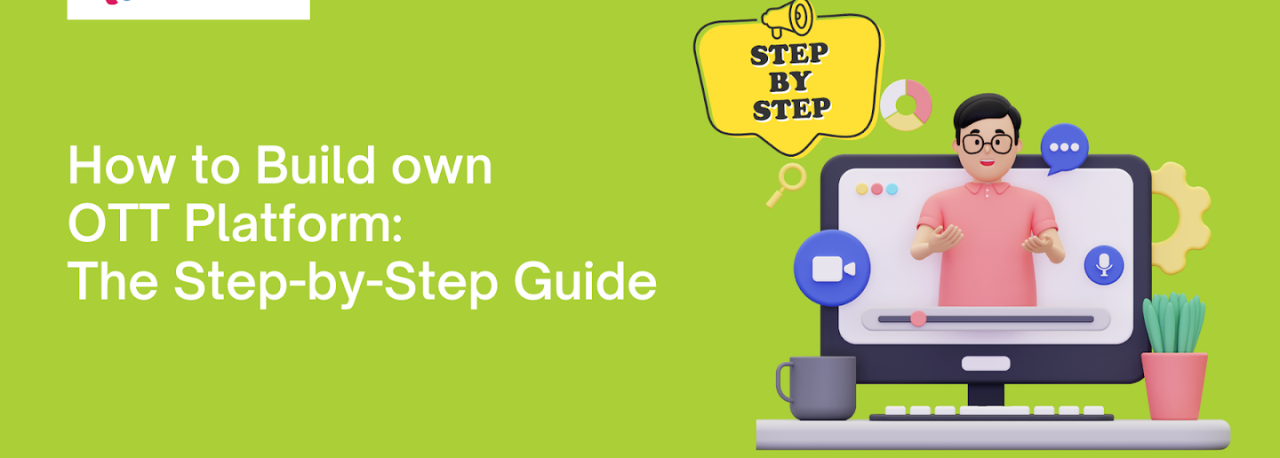In the digital age, entertainment and media consumption are increasingly dominated by Over-the-Top (OTT) platforms. The term “OTT” refers to streaming services that deliver content directly to viewers via the internet, bypassing traditional broadcasting methods like cable or satellite TV. The exponential rise of on-demand video consumption has transformed the media industry, with services like Netflix, Hulu, Disney+, and Amazon Prime Video becoming household names. As a result, more businesses are eager to build their own OTT apps to tap into this lucrative market.
Creating a successful OTT app, however, goes beyond just launching a streaming platform. It involves strategic planning, a robust technological framework, intuitive design, and a well-thought-out monetization strategy. This comprehensive guide will help you build an OTT app that can stand out in the highly competitive space and deliver a seamless user experience.
Understanding the OTT Landscape
Before delving into the intricacies of building an OTT app, it’s important to grasp the fundamentals of the OTT ecosystem. At its core, OTT platforms allow users to access digital content (such as video, audio, and other forms of media) via the internet without needing a cable provider or other traditional media intermediaries. The global popularity of OTT services is driven by the convenience of watching content anytime, anywhere, on any device.
Several trends have contributed to the rise of OTT platforms:
- Cord-Cutting: Many consumers have ditched traditional cable TV in favor of streaming services.
- On-Demand Content: Users are increasingly inclined to watch content on their schedule, not according to a broadcast timetable.
- Multi-Device Consumption: OTT apps are accessible on various devices, including smartphones, smart TVs, tablets, and gaming consoles.
Given this landscape, it’s clear that OTT platforms must prioritize user convenience, accessibility, and personalization to attract and retain viewers.
Step 1: Define Your Niche and Target Audience
To build an OTT app that resonates with your audience, you first need to define the niche of your content and identify your target users. Understanding the type of content you wish to offer is crucial to determining the structure and features of your app. Will your OTT platform focus on entertainment, live TV, sports, documentaries, educational content, or something more niche like fitness videos or cooking tutorials?
Identifying your niche helps create a focused content strategy. For instance, an OTT app dedicated to live sports may prioritize live streaming capabilities and real-time updates, whereas a platform focusing on educational content may need to incorporate interactive features such as quizzes and supplemental resources.
Once you have defined your niche, you must also determine the demographic you are targeting. Knowing your audience’s preferences, habits, and device usage will guide your design choices and inform your marketing and monetization strategies.
Step 2: Choose the Right Technology Stack
Choosing the right technology stack is essential for creating a scalable, flexible, and high-performance OTT app. The technology stack you choose will determine how well your app performs in terms of video delivery, security, and overall user experience.
Frontend Development
The frontend represents the user interface (UI) and user experience (UX) — the part of the app that users interact with directly. Given the wide variety of devices (mobile phones, smart TVs, desktops, etc.) on which OTT apps are accessed, building a responsive and intuitive interface is critical. Some popular tools for frontend development include:
- React Native: Ideal for creating cross-platform apps that work well on both Android and iOS.
- Flutter: Another excellent choice for cross-platform development, with a growing community of developers.
- Swift: Used for iOS app development, delivering smooth and efficient performance on Apple devices.
- Kotlin: A preferred choice for Android development, offering robust features for native apps.
Backend Development
The backend of your OTT app handles data management, video delivery, user authentication, and overall infrastructure. This is the engine that powers the app’s functionality, including video streaming, user profiles, subscriptions, and recommendations. A powerful backend ensures that your platform can handle large amounts of traffic, especially during peak viewing times.
Key components of the backend include:
- Cloud Storage: To store video content and media files. Leading cloud providers such as Amazon Web Services (AWS), Google Cloud, and Microsoft Azure offer scalable storage solutions.
- Content Delivery Network (CDN): CDNs, such as Akamai or Cloudflare, ensure that your content is delivered quickly to users across different regions by storing cached versions of your content closer to the end-users.
- Video Streaming Protocols: HLS (HTTP Live Streaming) and DASH (Dynamic Adaptive Streaming over HTTP) are common protocols used for delivering high-quality video streams, ensuring seamless playback across devices.
Security

Security is paramount when you build an OTT app, as content piracy and unauthorized access can lead to significant revenue loss. Implementing Digital Rights Management (DRM) and encryption ensures that your content is protected from theft and can only be accessed by authorized users.
Step 3: Design a Seamless User Experience
The user experience (UX) of your OTT platform can make or break its success. A well-designed UX ensures that users can easily navigate the app, discover content, and enjoy a personalized viewing experience. Here are some key design elements to focus on:
Personalization
Today’s users expect highly personalized content recommendations. Leveraging machine learning algorithms to analyze users’ viewing history and preferences allows you to offer tailored suggestions, increasing user engagement and retention. Personalization also extends to the user interface, where features such as multiple user profiles enable families or shared accounts to enjoy individualized content suggestions.
Intuitive Navigation
The layout of your OTT app should be easy to navigate. Menus, categories, and search functionality should be clearly visible, and users should be able to find content effortlessly. Features like genre filters, search by title, and recommended for you sections improve the overall discoverability of content.
Consistent Branding and Design
Your app’s visual design should reflect your brand identity. Maintaining consistency in color schemes, fonts, and logos across devices builds a stronger connection with your audience. A polished and professional design enhances the credibility of your platform and improves user trust.
Step 4: Implement Scalable Monetization Strategies
Monetizing your OTT app is a critical step in ensuring its sustainability and profitability. There are several ways to generate revenue from OTT platforms:
Subscription Video on Demand (SVOD)
This is a popular model where users pay a monthly or annual subscription fee for unlimited access to content. Services like Netflix, Hulu, and Disney+ utilize this model. SVOD is particularly useful for platforms offering exclusive or premium content.
Advertising Video on Demand (AVOD)
AVOD is an ad-supported model where users can watch content for free, but the platform earns revenue through advertisements. YouTube is a prime example of an AVOD model. This can be an attractive option for users who are unwilling to pay for content but don’t mind watching ads.
Transactional Video on Demand (TVOD)
In this model, users pay for individual pieces of content, such as renting or buying a movie or show. This is common for services like Amazon Prime Video, which offers a mix of subscription-based and transactional content.
Hybrid Models
Many platforms adopt a hybrid model, combining elements of AVOD, SVOD, and TVOD to maximize revenue potential. For example, you could offer free content supported by ads, while also offering a premium ad-free subscription tier.
Step 5: Test and Optimize
After development, testing your OTT app is crucial to ensure that it performs well under various conditions. Thoroughly test for:
- Performance: Ensure the app functions smoothly under high traffic and delivers consistent video quality without buffering.
- Device Compatibility: Test the app on different devices and operating systems (iOS, Android, smart TVs, etc.) to ensure universal accessibility.
- User Experience: Gather feedback on the design and navigation to make adjustments that improve user satisfaction.
Continual optimization is important after the app’s launch. Analyze user behavior data to determine what content is popular, where users are dropping off, and how long they’re engaging with the app. Regular updates based on user feedback and data analytics will help improve the app’s performance and user retention over time.
Step 6: Market Your OTT App
Successfully launching your OTT app requires a robust marketing strategy. To gain visibility and attract users, consider the following tactics:
- Social Media Marketing: Promote your app on platforms like Facebook, Instagram, and YouTube. Share trailers, exclusive previews, and behind-the-scenes content to generate interest.
- Influencer Partnerships: Collaborating with influencers in your niche can boost your app’s credibility and attract new users.
- SEO and ASO (App Store Optimization): Optimize your app’s title, description, and keywords in app stores to rank higher and attract organic traffic. Ensure your website is optimized for search engines using relevant keywords like build OTT app to attract potential customers.
Conclusion
The rise of OTT platforms has changed the way audiences consume content, and the demand for personalized, on-demand services continues to grow. By following this comprehensive roadmap, you can successfully build an OTT app that not only engages users but also generates sustainable revenue. From defining your niche and choosing the right technology stack to designing a seamless user experience and implementing scalable monetization models, each step plays a crucial role in creating a powerful OTT platform. With careful planning and continuous optimization, your app can thrive in the competitive OTT space.
